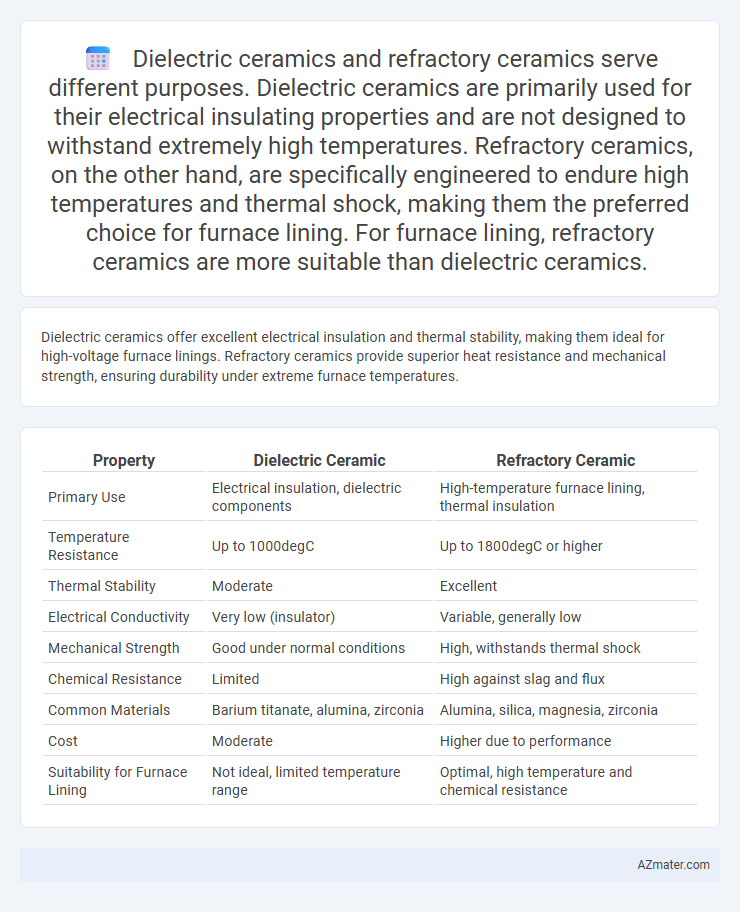Dielectric ceramics offer excellent electrical insulation and thermal stability, making them ideal for high-voltage furnace linings. Refractory ceramics provide superior heat resistance and mechanical strength, ensuring durability under extreme furnace temperatures.
Table of Comparison
| Property | Dielectric Ceramic | Refractory Ceramic |
|---|---|---|
| Primary Use | Electrical insulation, dielectric components | High-temperature furnace lining, thermal insulation |
| Temperature Resistance | Up to 1000degC | Up to 1800degC or higher |
| Thermal Stability | Moderate | Excellent |
| Electrical Conductivity | Very low (insulator) | Variable, generally low |
| Mechanical Strength | Good under normal conditions | High, withstands thermal shock |
| Chemical Resistance | Limited | High against slag and flux |
| Common Materials | Barium titanate, alumina, zirconia | Alumina, silica, magnesia, zirconia |
| Cost | Moderate | Higher due to performance |
| Suitability for Furnace Lining | Not ideal, limited temperature range | Optimal, high temperature and chemical resistance |
Introduction to Ceramic Materials for Furnace Lining
Dielectric ceramics and refractory ceramics serve distinct roles in furnace lining due to their intrinsic material properties. Dielectric ceramics offer excellent electrical insulation and low thermal conductivity, making them ideal for applications requiring minimal heat loss and electrical resistance. Refractory ceramics exhibit superior thermal stability and resistance to chemical corrosion at high temperatures, ensuring prolonged durability and structural integrity under extreme furnace conditions.
Defining Dielectric Ceramics
Dielectric ceramics, characterized by their high electrical resistivity and low dielectric loss, are specifically engineered to prevent electrical conduction within furnace linings, ensuring safety in high-voltage environments. Unlike refractory ceramics, which prioritize thermal stability and resistance to mechanical wear at extreme temperatures, dielectric ceramics optimize insulating properties while maintaining adequate thermal resistance for furnace applications. These materials typically include alumina, silica, and zirconia variants that provide a balanced combination of dielectric strength and thermal endurance crucial for efficient furnace operation.
Understanding Refractory Ceramics
Refractory ceramics provide superior thermal stability and resistance to chemical corrosion, making them essential for furnace lining applications exposed to extreme temperatures. These materials often include alumina, silica, and magnesia, which maintain structural integrity at temperatures above 1500degC. In contrast, dielectric ceramics primarily offer electrical insulation but lack the high-temperature resilience required for prolonged furnace linings.
Key Properties Comparison: Dielectric vs Refractory Ceramics
Dielectric ceramics for furnace lining exhibit high electrical insulation, low dielectric loss, and excellent thermal stability up to moderate temperatures, making them ideal for applications requiring electrical isolation. Refractory ceramics offer superior resistance to extreme heat, thermal shock, and corrosion, maintaining structural integrity at temperatures exceeding 1600degC, which suits high-temperature furnace linings. Their key difference lies in dielectric ceramics prioritizing electrical properties, while refractory ceramics emphasize mechanical strength and thermal endurance under harsh conditions.
Performance Under High Temperatures
Dielectric ceramics exhibit excellent electrical insulation and thermal stability, making them ideal for furnace linings where minimizing electrical conduction is critical, especially at temperatures up to 1000degC. Refractory ceramics offer superior mechanical strength and resistance to thermal shock, maintaining structural integrity and insulating properties under extreme temperatures exceeding 1500degC. Performance under high temperatures depends on specific furnace requirements; dielectric ceramics excel in insulating for electrical applications, while refractory ceramics dominate in environments demanding maximum heat resistance and durability.
Thermal and Electrical Insulation Capabilities
Dielectric ceramics used in furnace lining exhibit superior electrical insulation properties, maintaining high resistivity and preventing electrical current flow even at elevated temperatures. Refractory ceramics provide excellent thermal insulation due to their ability to withstand extreme heat and minimize thermal conductivity, enhancing energy efficiency and protecting furnace structure. Combining dielectric and refractory ceramics can optimize furnace lining performance by balancing thermal insulation with exceptional electrical insulation capabilities.
Chemical Resistance and Durability
Dielectric ceramics exhibit superior chemical resistance to corrosive gases and molten salts, making them ideal for furnace linings exposed to aggressive environments. Refractory ceramics offer exceptional durability under high thermal stress and mechanical abrasion, ensuring long service life in extreme temperature conditions. Both materials provide crucial performance benefits, with dielectric ceramics excelling in chemical stability and refractory ceramics in thermal and mechanical resilience.
Application Suitability in Furnace Environments
Dielectric ceramics, known for their excellent electrical insulation properties and thermal shock resistance, are ideal for furnace linings in high-frequency or microwave furnace applications where electrical insulation is critical. Refractory ceramics, characterized by their superior high-temperature stability, mechanical strength, and resistance to chemical corrosion, are better suited for traditional high-temperature furnace environments involving molten metals or extreme thermal cycles. Selecting between dielectric and refractory ceramics depends on the furnace's operational temperature, atmosphere, and electrical requirements to ensure optimal performance and longevity.
Cost and Availability Considerations
Dielectric ceramics typically have higher material costs due to specialized compositions designed for electrical insulation but may offer longer lifespan and energy efficiency in furnace linings. Refractory ceramics are generally more affordable and widely available, with established supply chains supporting high-temperature resistance applications, making them cost-effective for large-scale or conventional furnace linings. Availability of refractory ceramics tends to be better globally, whereas dielectric ceramics may require sourcing from specialized manufacturers, impacting lead times and overall project costs.
Choosing the Right Ceramic for Furnace Lining
Dielectric ceramics offer excellent electrical insulation and thermal stability, making them ideal for furnace linings in applications requiring high-voltage resistance. Refractory ceramics excel in withstanding extreme temperatures and corrosive environments, providing durability and structural integrity for high-temperature furnace linings. Selecting the right ceramic depends on balancing electrical insulation needs with thermal and chemical resistance requirements of the specific furnace operation.

Infographic: Dielectric ceramic vs Refractory ceramic for Furnace lining
 azmater.com
azmater.com